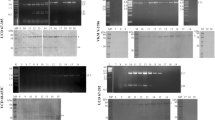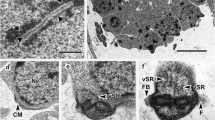Abstract
Chilo Iridescent virus (Iridovirus type 6 or CIV) infection results in a disaggregation of the heavy polyribosomes both in permissive and non-permissive invertebrate cell lines. The integrity of the viral genome is not involved in this event, as shown by the polysome absorbance profile on sucrose gradient, prepared from cells infected with UV treated virus. Heavy polysomes reappeared in permissive infected cells during the viral replication cycle.
Similar content being viewed by others
References
Braunwald J, Guir J, Obert G (1972) Inhibition de la synthese des proteines cellulaires dans les cellules KB infectées avec le virus FV3 de la grenouille (FV3). Ann Inst Pasteur 123:251–264
Njayou M, Drillien R, Kirn A (1982) Characteristics of the inhibition of protein synthesis by vaccinia virus in non permissive chinese hamster ovary cells. Ann Virol (Inst Pasteur) 133E:393–402
Person A, Beaud G (1978) Inhibition of host protein synthesis in vaccinia virus-infected cells in the presence of cordycepin (3′-deoxyadenosine). J Virol 25:11–18
Cerutti M, Devauchelle G (1980) Inhibition of macromolecular synthesis in cells infected with invertebrate virus (Iridovirus type 6 or CIV). Arch Virol 63: 297–303
Kelly DE, Tinsley TW (1972) Proteins of iridescent viruses type 2 and type 6. J inverte Pathol 19:273–275
Guerillon J, Barray S, Devauchelle G (1982) Crossed Immunoelectrophoretic characterization of Chilo Iridescent virus surface antigens. Arch Virol 73:161–170
Cerutti M, Guerillon J, Arella M, Devauchelle G (1981) La replication de l'Iridovirus de type 6 (CIV) dans différentes lignées cellulaires. CR Acad Sc Paris, 292: 797–802
Barray S, Devauchelle G (1985) Protein synthesis in cells infected byChilo Iridescent virus (Iridovirus, type 6). Arch Virol (in press)
Spradling A, Hui H, Penman S (1975) Two very different components of messenger RNA in an insect cell line. Cell 4:131–137
Zylber EA, Penman S (1971) The effect of high ionic strength on monomers, polyribosomes and puromycine treated polyribosomes. Biochim Biophys Acta 204: 221–229
Luria SE, Darnell EJ, Baltimore DJ, Campbell A (1978) General virology 3rd ed. John Wiley and sons, New York
Cerutti M, Devauchelle G (1982) Isolation and reconstitution ofChilo Iridescent virus membrane. Arch Virol 74:145–155
Ison HC, Liao WSL, Taylor JM, Willwert HGE, Eadline TS (1983) Rapid and selective shut off of plasma protein production in Herpes simplex virus type 2-infected hepatoma cells. Virology 126:548–562
Sagot S, Beaud G (1979) Phosphorylation in vivo of a vaccinia virus structural protein found associated with the ribosomes from infected cells. Eur J Biochem 98:131–140
Michael J, Bartkoski JR (1982) Polysome associated in Herpes simplex virus infected cells. J Virol 43:357–360
Author information
Authors and Affiliations
Rights and permissions
About this article
Cite this article
Petit, F., Devauchelle, G. Isolation of polysomes from permissive and non-permissive invertebrate cell lines infected with chilo iridescent virus. Med Microbiol Immunol 174, 67–71 (1985). https://doi.org/10.1007/BF02123227
Received:
Issue Date:
DOI: https://doi.org/10.1007/BF02123227




